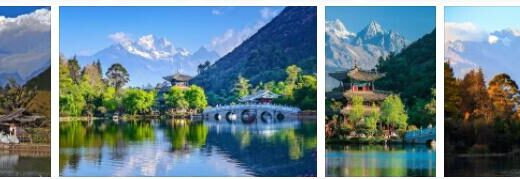Mogao Caves (World Heritage)
The Mogao Caves are an important Buddhist pilgrimage site. You are on a rock face in the western part of Gansu Province. The site has been continuously expanded since the 4th century. Of the around 1000 caves, 427 are still preserved today. They document the heyday of Buddhist art with wall paintings, sculptures, sculptures and stone carvings.
Mogao Caves: Facts
| Official title: | Mogao Caves |
| Cultural monument: | 492 shrines carved in stone in a 1.6 km long rock wall near the Silk Road, 45,000 m² frescoes and 2,400 painted sculptures with a size of 10 cm to 33 m reflecting Buddhism and Tantrism, by Sir Aurel Stein purchase of 3,000 rolls and 6,000 manuscripts, paintings and sculptures for the British Museum in London; 4,000 documents purchased by Paul Pelliot for the Musée Guimet in Paris |
| Continent: | Asia |
| Country: | China, Gansu |
| Location: | southeast of Dunhuang Oasis on the Dang River |
| Appointment: | 1987 |
| Meaning: | a gem of Buddhist art |
Mogao Caves: History
| 206 BC BC-220 AD | since the time of the Han dynasty, Dunhuang has been an important oasis city on the Silk Road |
| 117 BC Chr. | Establishment of a military command in Dunhuang |
| at 366 | Creation of the first cave |
| 444 | Buddhism State religion in the kingdom of Toba-Wei |
| 618-907 | in the time of the Tang dynasty mainly the famous cave temples of Mogao |
| 790-851 | Occupation by the Tibetans |
| 1036-1227 | Lamaist sects spread under the Xia dynasty |
| 1899 | Rediscovery of the cave temples |
| 1900 | first restoration and discovery of 50,000 manuscripts that were hidden in a walled niche in 1036 |
| 1907 | Visit of the researcher Sir Aurel Stein (1862-1943) |
A gallery under desert sand
Deep in the heart of the Gobi Desert, on the western border of the Chinese Empire and the branching of the caravan routes through Central Asia into a southern and a northern route, in a place called Dunhuang was once filled with silk, ceramics, jade, gold and other treasures from China, India and the Middle East traded. After having been on the Silk Road for weeks, many caravan drivers stopping in this place thanked Buddha for a successful journey or pleaded with him before they exposed themselves again to the dangers of the desert.
In the year 366, according to an old inscription in cave number 392, a Buddhist monk named Lezun had a vision at the gates of Dunhuang. A magical light appeared over the peaks of a nearby mountain range, which he interpreted as a sign of the gods. He is said to have carved the first grotto in honor of Buddha in the sandstone cliffs in the valley of the now dried up river Dang. Countless believers followed his example over the next few centuries. The cult caves still preserved today contain hundreds of portraits of saints made of sandstone and painted stucco, the size of which varies from a few centimeters to a monumental 33 meters.
The center of worship is always the image of the Buddha on the lotus throne, wrapped in a simple monk’s toga and immersed in meditation. His two favorite disciples, Ananda and Kasyapa, lavishly decorated saints “crowned” with high, pointed headgear and grim-looking guardian figures stand by the enlightened one on the right and left.
In the paintings and sculptures the motif of the apsaras recurs again and again, angelic beings who glide gracefully through the air in fragrant robes and reverently buzz around the Buddha and his saints. Episodic, almost in the manner of comic strips, scenes from the life of Buddha and famous legends are told for believers who are not able to read and write. Prince Mahasattva, for example, offers himself to a tigress in a representation that adorns cave number 428, in order to save them from certain starvation. With this act he shows boundless compassion towards all creatures. Breaking out of the eternal cycle of rebirths, he becomes a Bodhisattva, a saint, who selflessly renounces the entrance into nirvana and instead helps disoriented people in their search for salvation. In addition to such religious themes, scenes from everyday life can also be found. You can see merchants making the arduous journey through the desert, farmers tilling their fields and princes who are entertained by lovely dancers in their magnificent palaces. According to thereligionfaqs, these paintings of inestimable value – because nowhere in China have paintings from this early period been better preserved than here – allow the viewer a journey through a thousand-year-old Chinese art and cultural history.
The relatively good condition of the caves is due to the dry desert climate and the fact that the cult caves were forgotten for almost half a millennium after they were abandoned in the 15th century and the desert had taken them over. High sand dunes blew the entrances and protected paintings and sculptures from weathering. Only at the end of the 19th century were the grottoes rediscovered by chance by the monk Wang Yuanlu. Later he came across a library that contained more than 50,000 ancient writings. Western scientists soon found out about this treasure too, such as the Hungarian adventurer Sir Aurel Stein, who was the first to appear in Dunhuang in 1907 and who, on behalf of the English crown, bought the most valuable documents at a ridiculous price.



